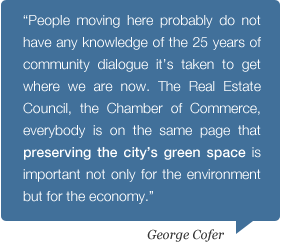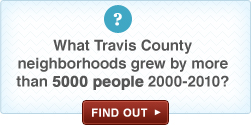An Austinite, popping down to Zilker Park on a weekend morning, will be surrounded by joggers and cyclists, families feeding swans, speed walkers and meanderers. It can be a bit of a traffic snarl. Even Lady Bird Lake is crowded with rowers, kayakers, standup paddlers and canoeists. As glorious as it is to live in a city with green spaces and so many people who appreciate them, it poses a conundrum: How are those green spaces going to fare as the city’s population continues to swell?
There already can be long lines to get into places like Barton Springs, Hamilton Pool and Enchanted Rock sometimes requiring more than an hour’s wait. The streets surrounding Green Belt entrances are packed with cars and swimming holes can resemble the beach at spring break. What happens when, as predicted by the Austin Chamber of Commerce population figures, the Austin metropolitan population grows to more than two million by 2020 and more than three million by 2030? Even if Austinites can handle the crowds, how will the ecosystem fare?
Fortunately, some local groups have been pondering those questions for decades, says George Cofer, Executive Director of Hill Country Conservancy (HCC).
“People moving here probably do not have any knowledge of the 25 years of community dialogue it’s taken to get where we are now,” says Cofer. “The Real Estate Council, the Chamber of Commerce, everybody is on the same page that preserving the city’s green space is important not only for the environment but for the economy.”
Whereas some Western states have devoted up to 70 percent of the land for public use, Cofer says, very little of Texas’s land is in the public hands. He estimates 1-3 percent. So it’s up to private organizations to preserve green space for public use.
Two organizations that have been working to do that include HCC and Austin Parks Foundation.
 Hill Country Conservancy saves the land for future generations
Hill Country Conservancy saves the land for future generations
HCC has been working with the City of Austin and nearby counties as well as U.S. Parks and Wildlife and other organizations to acquire land and rights for conservation easements since the 1990s. Much of the focus has been on protecting land with direct access to watersheds and aquifers. Over the decades, HCC has struggled against rising land prices and competition from commercial buyers who can offer more money to prospective sellers.
Some of the land HCC has acquired will be open to the public in trails, such as the Violet Crown Trail which will run from Zilker Park, more than 30 miles south into Hays County. HCC has more than a dozen partners on the project including the Lady Bird Johnson Wildflower Center and the McCombs School of Business at the University of Texas.
Some of the land will remain in private hands as conservation easements. Though ownership remains with the original landholders — some of them historic Texas ranching families — development rights are dissolved “in perpetuity.” In essence, that means the families must leave the land in its natural state forever, thus protecting aquifers, rivers, streams, scenic vistas, wildlife habitat, and the rural heritage of Central Texas for generations to come.
Conservation easement agreements are created between the landowner and HCC. To meet the needs of each landowner, every easement is different, Cofer says.
“On any property where there’s a conservation easement, we always have conversations about what future needs may be. A landowner may reserve the right to build two or three homes, set aside 100 acres for the kids, build a nature tourism lodge or a barn,” Cofer says. “We work with each family to make sure the easement makes sense for the best use of the land and for the family’s future.”
 The Dahlstrom family, a historic ranching family with a 2,254 acre ranch on Onion Creek near Buda, set aside nearly 400 acres for public access, education and nature programs.
The Dahlstrom family, a historic ranching family with a 2,254 acre ranch on Onion Creek near Buda, set aside nearly 400 acres for public access, education and nature programs.
Other private landholders, including those building housing developments and multi-family units see value in conservation easements because the access to green space increases property values.
In rapidly growing areas like Hays and Travis counties, HCC is able to use donations large and small to match Federal Grants. In doing this, HCC strategically leverages dollars to continue protecting thousands of acres that might otherwise be lost to Austin’s burgeoning growth for a fraction of the price.
Committed to protecting the clean water, wildlife, and rural character that are currently threatened, HCC’s philosophy is simple: Once Hill Country land is gone, it’s gone for good. When HCC preserves it, it’s here forever.
Get Involved with Hill Country Conservancy
![]()
 Austin Parks Foundation equips people who have a passion for green
Austin Parks Foundation equips people who have a passion for green
Collin Wallis, Executive Director of the Austin Parks Foundation, remembers a few years ago when Lady Bird Lake was nearly unpopulated on a weekend morning, as were the trails. But he sees the surging number of people using the parks as a good thing. Yes, the population of Austin is growing; but the newcomers appreciate Austin’s green spaces. And that’s important for a small organization like Austin Parks Foundation which operates on a $1.5 million budget and the sweat equity and good will of local citizens.
Wallis believes if Austin is to preserve its parks, it will be through the work of the people who use them, because city funding will not stretch far enough.
“In Austin, people are very passionate about parks,” Wallis says. “They’re out doing these projects in their neighborhood parks... but they’re not really well coordinated. We’re working on how to bring these people together to work with one voice.”
Austin Parks Foundation helps small groups organize to take care of local parks. They provide grants of $500 to $50,000 which grantees must match with volunteer labor, community fundraising and in-kind donations—such as park equipment. To date, the organization funded nearly a hundred projects totaling $1 Million dollars.
They also provide administrative and technical assistance for managing grants. The grants are funded by ticket sales from the Austin City Limits Music Festival and the founding funders, Nancy Bowman and the Shield-Ayers Foundation.
The foundation also handles financial services for park groups so they can raise money under the foundation’s 501c3 banner. This makes any donations to the park tax-deductible and also allows the group to purchase materials and supplies as a non-profit. Some successful groups that use this financial umbrella have included Pease Park Conservancy and the Friends of Barton Springs Pool.
The foundation also offers technical help, assists in coordinating workdays and lends tools to groups for park projects. In short, if a community wants its park taken care of, Austin Parks Foundation finds a way to help them get it done. But, as Wallis said, it depends on a population that cares about its green spaces.
 “The important thing as the population grows is for people to take responsibility for their parks,” Wallis says. “Don’t just stand-up-paddle board on the lake in your spare time, but do something to make your lake a better place. No matter how much money the city has, it’s never going to be enough. People have to take some ownership of outdoor spaces. We’re a mechanism for people who want to get involved and do something about it.”
“The important thing as the population grows is for people to take responsibility for their parks,” Wallis says. “Don’t just stand-up-paddle board on the lake in your spare time, but do something to make your lake a better place. No matter how much money the city has, it’s never going to be enough. People have to take some ownership of outdoor spaces. We’re a mechanism for people who want to get involved and do something about it.”












